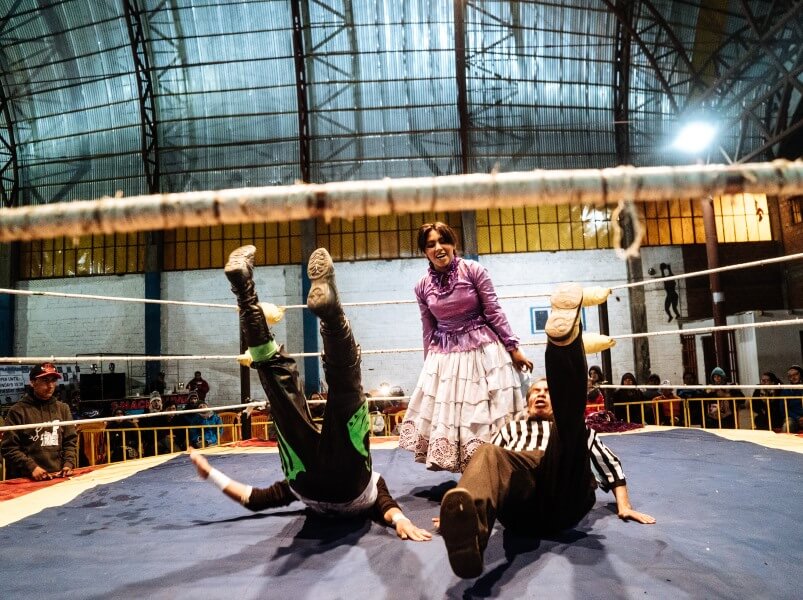
By Kamran Ali
Photographer19 Oct 2017 - 7 Minute Read
A woman dressed in a heavy, multi-layered skirt delivers a series of powerful slaps to her opponent before dragging her across the ring by her braids. She then spits water on her face before smashing the bottle on her head. The audience boos and jeers, while the referee intentionally looks away. Suddenly, the victim makes a surprising flip and pins the villainous wrestler down. The referee counts to three, and the commentator announces the triumph of good over bad. The audience bursts into cheers and applause!

They are the Fighting Cholitas, a group of woman wrestlers in Bolivia, who fight twice a week in El Alto in front of hundreds of spectators. To a casual visitor, the fights may appear to be just another scripted gimmick, but the roots of this fascinating combat run deep. Oppressed for centuries by their fellow Bolivians, these women are avenging themselves in a class-based, male-dominant society to reclaim the respect that they deserve.

In the El Alto colosseum, roughly 13,000ft (4,000m) above sea level in the hills above La Paz, the commentator announces the next fight. Loudspeakers blast Andean dance music. Smiling Cholitas in colorful pollera skirts, bowler hats, and fringed shawls make a dramatic entrance. They dance and circle around in front of the cheering spectators.
The music stops, and the air around the hexagonal ring becomes tense. The Cholitas take off their hats, shawls, and jewelry and put them aside. Their once-smiling faces now scowl in anger and disgust. The musty arena is deathly silent, all eyes on the women inside the ring. The fight is about to begin!


History of the Cholitas
The word Cholita comes from the Spanish word cholo (chola for females) meaning mixed-race. It refers to people with one Amerindian parent and one second-generation Spanish parent. The diminutive “ita” in Spanish indicates “small,” and is used affectionately.
As women from a socially marginalized community, the Cholitas have faced not just social, economic, and political challenges but also gender discrimination. But they haven’t given up. A group of Cholita fighters is now resisting the patriarchy both inside and outside the ring.

Lucha Libre-style wrestling in Bolivia
When the wrestling organizers in El Alto introduced women wrestlers as a marketing ploy, Cholitas jumped at the opportunity. The Fighting Cholitas in their elaborate attire became an instant hit. They formed an independent association, and now they manage their own fights.
Their style of wrestling is called Lucha Libre (free fighting). It’s known for acrobatic moves that execute a good-versus-evil fight, with a dramatic story line.


One wrestler plays the role of a bad guy – the nasty antagonist who uses unfair means in their attempts to win. The opponent plays the good guy – the protagonist who is polite, follows the rules, and uses elegant and highly technical moves to counter their opponents. The good guy wins the support of the audience, while the bad guy is often helped by the referee, who willfully ignores the unfair tactics. As with most popular tales, the good always wins over the bad, leaving the audience satisfied that justice has been done.


It takes about a year of training for a Cholita to become a luchadora (fighter). A fighter can be anywhere between 16 and 70 years old and earns about US$20-25 for one fight. Although the fight is scripted, the moves and falls are real. Sometimes wrestlers are seriously injured and have to spend days in the hospital at their own expense. So most Cholitas have other jobs, aside from their wrestling careers.
Cholita dress and culture
Unlike the WWF women wrestlers who wear tight, revealing garments, the Cholitas prefer to wear the same costume inside the ring that they wear outside. Though this garb was enforced upon the Aymara population by the Spanish in the 18th century, as a way of caste classification, the distinctive pollera dress is now a symbol of the Aymara identity, and the Cholitas take pride in it. Wrestling in a ladylike dress is also a statement: women do not have to compromise on their identity to compete with men.

Their unusual fighting attire captures attention – their femininity makes the spectators marvel at their strength. But the wrestling Cholitas are not about appearances. In fact, their fight is not really about the match inside the ring at all.
The Cholitas have now become a visual symbol of Bolivia. And even though their pay is still low, they are finding their way into universities and better-paying jobs. Their fight is a statement – against social and gender discrimination, exotification, and objectification. Although things are looking up, they continue to fight to show that when justice is not served, it has to be fought for.


Discover similar stories in
discovery
Photographer
Kamran Ali is a cyclist and photographer, born and raised in Pakistan and currently on a 3-year, 30,000km bicycle journey from Argentina to Alaska.


3 Comments
Wonderful to read of the Cholitas empowerment and advancement; thanks for sharing your story.
Bolivia offers so much!
in all the writings i have read that you share with the world, i love your seeming sense of understanding of the human element of these places. you seem to have a warm understanding and sentiment of the human condition; not the colorful, flashy, "flavor of the month" perspective that is so published these days. love your depth of indulging in the experiences you write about. thank you so much, dona